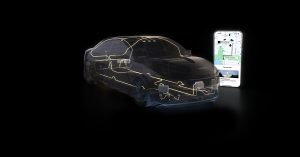ZF Liftec has recently unveiled a revolutionary dual contour airbag system aimed at enhancing safety in automated driving environments. This innovative airbag adjusts its inflation according to the occupant’s seating position and body characteristics, promising improved protection, especially in the more relaxed seating postures facilitated by autonomous driving technologies.
With the rise of automated driving, vehicle occupants will have the freedom to alter their seating positions. To ensure maximum safety during a crash, ZF Liftec’s passenger-side airbag can inflate in two distinct sizes, tailored to the occupant’s seating arrangement. Additionally, a similar dual contour airbag is being developed for the driver’s side to accommodate future partially or fully automated vehicles.
As Level 3 autonomous driving technology becomes approved in more regions, drivers will be able to divert their attention from the road while the system is active, though they must remain ready to take control if needed. Level 4 fully autonomous driving might remove this requirement on certain routes, allowing for even more comfortable seating adjustments. Current safety mechanisms, however, are designed primarily for traditional upright seating positions.
Crash tests have highlighted that in frontal collisions, conventional seat belt and airbag systems may not provide optimal protection if occupants are in more relaxed positions, such as a seatback angle of around 40°. This is due to the increased distance between the occupant and the airbag, diminishing its protective efficacy.
Harald Lutz, head of development at ZF Liftec, emphasized the company’s commitment to safety: “Our goal is to ensure that occupants in more relaxed seating positions receive safety standards comparable to those in non-automated driving scenarios.”
The creation of the dual contour passenger airbag has also influenced the development of a similar system for the driver’s side. This airbag features two inflation stages, controlled by a sophisticated system of bag-cushion-tethers and an active release mechanism. This system adjusts the airbag’s size based on the occupant’s seating position, ensuring optimal protection.
Lutz described this advancement as a significant achievement: “This is the absolute benchmark in this field.”
To meet the demands of the dual contour airbag, ZF Liftec has designed a two-stage gas generator capable of inflating the airbag’s varying volumes within milliseconds. This technology enables a depth adaptivity of approximately 200mm on the driver’s side, while the passenger side can achieve a maximum inflation volume of up to 190 liters.
The airbag control system works seamlessly with the vehicle’s electronics to detect the occupant’s seating position and adjust the gas generator accordingly. Additional sensors, such as interior cameras, can enhance the precision of these adjustments.
Moreover, the system can modify inflation pressure based on the occupant’s size, weight, and body type, optimizing restraint by adjusting air vents as necessary.
Lutz noted that “With this adaptive system, already implemented in other series applications by ZF Liftec, the airbag’s restraint function is more efficient and aligns with the ‘real-life safety’ approach.”
ZF Liftec’s dual contour airbag represents a significant leap forward in vehicle safety technology, particularly as the industry moves towards more autonomous driving solutions. This development underscores the importance of adapting traditional safety measures to meet the evolving needs of automated driving environments, ensuring that all occupants are well-protected regardless of their seating position.







